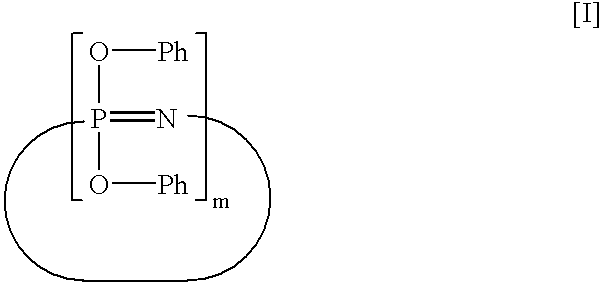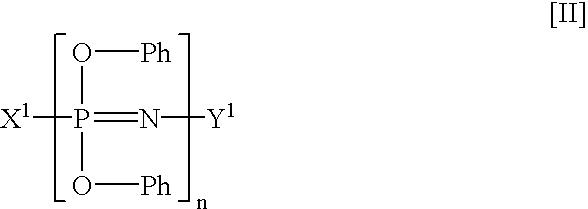Flame retardant resin composition
a technology composition, which is applied in the field of flame retardant resin composition, can solve the problems of insufficient mechanical properties of compositions prepared by blending magnesium hydroxide in polyamide resin, insufficient mechanical properties of compositions, and insufficient flame retardant properties, etc., and achieve excellent flame retardant properties, mechanical properties and heat resistance.
- Summary
- Abstract
- Description
- Claims
- Application Information
AI Technical Summary
Benefits of technology
Problems solved by technology
Method used
Image
Examples
synthesis example 1
Production of Phenoxy Phosphazene
[0058]A 1-liter four neck flask equipped with a stirrer, a thermometer and a reflux condenser was charged with 1.30 mol (123.0 g) of phenol and then with 500 milliliters (ml) of tetrahydrofuran (THF). The contents of the flask were stirred to form a uniform solution. While maintaining the solution at a temperature of not more than 25° C., 7.6 g of metal sodium was charged into the flask, and then the Aside temperature of the flask was increased up to 62° C. for one hour, thereby preparing a sodium phenolate solution. Separately, 290 g of a 20 wt. % chlorobenzene solution containing 0.5 unit mol (58 g) of a dichlorophosphazene oligomer (a mixture comprising 59% by weight of trimer, 12% by weight of tetramer, 11% by weight of pentamer and hexamer, 3% by weight of heptamer, and 15% by weight of octamer and higher oligomers) was charged into a 2-liter four neck flask. The previously prepared sodium phenolate solution was dropped into the chlorobenzene so...
synthesis example 2
Production of Phenoxy Phosphazene Compound Having a Cross-Linking Structure Containing P-Phenylene as Cross-Linking Group
[0060]A 2-liter four neck flask was charged with 204 mol (196.0 g) of phenol, 2.04 mol (82 g) of sodium hydroxide and toluene. The contents of the flask were subjected to azeotropic dehydration, thereby preparing about 1,200 g of a 20% sodium phenolate toluene solution Separately, 580 g of a 20% chlorobenzene solution containing 1 unit mol (115.9 g) of a dichlorophosphazene oligomer (a mixture having the same composition as in Synthesis Example 1) was charged into a 2-liter four neck flask. While stirring the chlorobenzene solution, a separately prepared 10% toluene solution containing 0.15 mol (18.3 g) of a hydroquinone dilithium salt was dropped thereinto at a temperature of not more than 25° C. After completion of dropping, the resultant mixture was reacted under stirring at 50° C. for 5 hours. Successively, 1,200 g of the previously prepared 20% sodium phenola...
synthesis example 3
Production of Phenoxy Phosphazene Compound Having a Cross-Linking Structure Containing 2,2-(4,4′-diphenylene)isopropylidne as Cross-Linking Group
[0062]A 2-liter four neck flask was charged with 86.7 g (0.38 mol) of bisphenol A and 460 ml of THF. The contents of the flask were stirred and dissolved to prepare a uniform solution. While maintaining the temperature of the solution at 19° C., 3.5 g (0.5 gram equivalent) of sliced metal lithium was added into the solution. The solution was maintained at a temperature of 61 to 68° C. for one hour, thereby preparing a lithium salt of bisphenol A.
[0063]Separately, a 2-liter four neck flask was charged with 215.6 g (2.25 mol) of phenol and 500 ml of toluene. While maintaining the liquid temperature in the flask at 25° C. under stirring, 34.5 g (1.5 gram equivalent) of sliced metal sodium was charged into the flask. The inside temperature of the flask was increased up to 77° C. for 4 hours. The contents of the flask were continuously stirred a...
PUM
| Property | Measurement | Unit |
|---|---|---|
| mol % | aaaaa | aaaaa |
| temperature | aaaaa | aaaaa |
| diameter | aaaaa | aaaaa |
Abstract
Description
Claims
Application Information
 Login to View More
Login to View More - R&D
- Intellectual Property
- Life Sciences
- Materials
- Tech Scout
- Unparalleled Data Quality
- Higher Quality Content
- 60% Fewer Hallucinations
Browse by: Latest US Patents, China's latest patents, Technical Efficacy Thesaurus, Application Domain, Technology Topic, Popular Technical Reports.
© 2025 PatSnap. All rights reserved.Legal|Privacy policy|Modern Slavery Act Transparency Statement|Sitemap|About US| Contact US: help@patsnap.com



